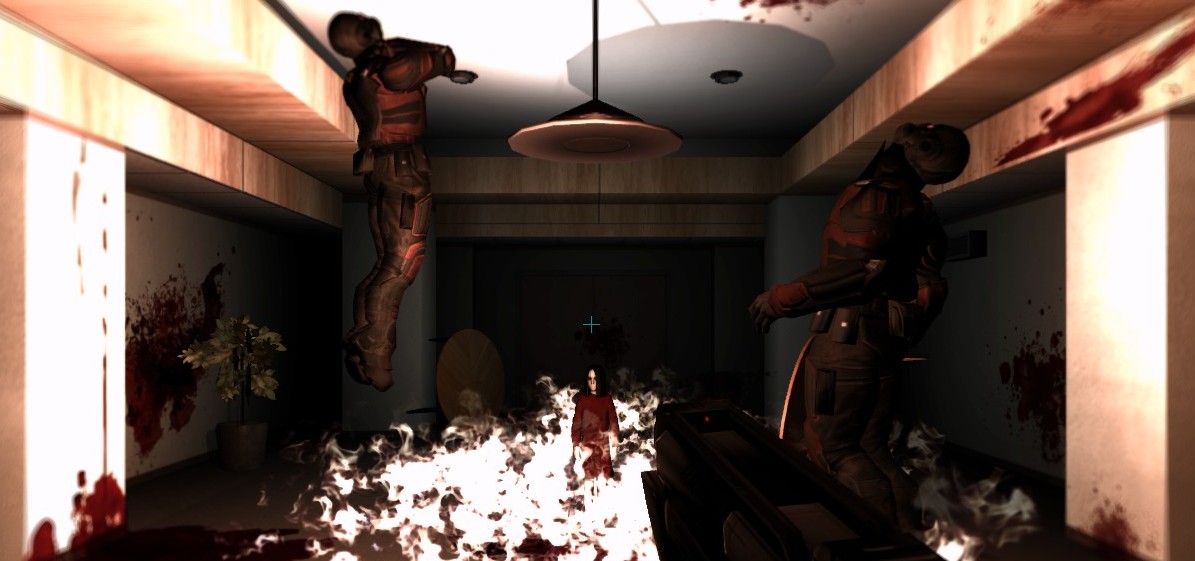The Horror
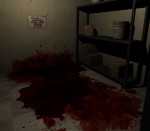
Shooting clones is the meat of the game, but F.E.A.R.‘s combat meat is marbled with psychological horror fat. Throughout the game, you encounter a variety of supernatural phenomena. The most common occurrences of these events are innocuous stuff like random lights flickering, or crackling sounds on the radio. A few of these events involve the sudden motion of a physical object. You’ll see ceiling tiles fall down, elevators plummeting down shafts, and a crow may greet you in its native language. From time to time, you will find gallons of blood all over the floor, wall, or ceiling. Other times, you have a hallucination or vision of some sort. Some of these visions are flashbacks, which reveal moments that occurred at some point before you entered the area, but many of the visions are simply spooky for the sake of spooky. A lot of the time, you see Fettel, who either walks around or stares at you, perhaps saying something cryptic, before dispersing into a cloud of flakes. Other times, you see Alma, the spooky girl.
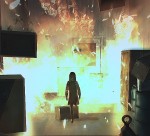
Alma is one of the central characters in the game, albeit a rather confusing one. Because the horror genre demands it, Alma is not explained in advance, and we are left to figure out what she is over the course of the game. When we first see Alma, we see her walking towards some soldiers, as their flesh sublimates from their bones. When she next appears, we see her standing in a large explosion that we leap away from. I guess we’re supposed to infer from this that Alma is a dangerous little girl. However, for most of the rest of the game, Alma just stands there, or walks around. Sometimes, she whispers. She seems to pop in now and then, hoping her presence alone would scare us. The problem with this is that she isn’t accompanied by the violence from her first appearance, or by the big explosion from the second one. Without those, you just have a girl with a red dress and long black hair, and this isn’t inherently scary. She may startle you with a sudden appearance, but really, anything can potentially startle you by popping out of nowhere, especially if accompanied by a loud orchestral sting.
Fettel also lends a questionable presence every now and then. For most of the game, the primary objective is to hunt him down. Fettel commands the clone soldiers, and if he is taken down, the clones will become inactive. In the first chapter of the game, after finding the dead body of one of his victims, you encounter Fettel as he swings a 2×4 into your forehead. While you’re on the floor, mano-a-mano with unconsciousness, he softly delivers some cryptic exposition directly into your sore face. When you get back up, he’s gone. He could have easily killed you, and we already know by this point that he’s more than capable of doing so. As you proceed, his psychically-commanded clone goons try to shoot you to death. You would think this means that he now wants you dead, and yet, every subsequent time you run into Fettel, he gives you cryptic information instead of killing you personally. No matter how you rationalize it, this is a confusing conflict of interest. Either Fettel should be trying to kill you himself, or his clones should be using a less lethal means of defending themselves. Whenever he appears, it seems like his only purpose is to confuse us.

Along with the attempted jump scares, F.E.A.R. attempts to build atmosphere and suspense by making you travel through a lot of dark places. Because someone had gone through the trouble to tape a flashlight to your head, you can fearlessly traverse the many darkened corridors. Unfortunately for you, this is a video game flashlight. If you leave it on for about 30 seconds, it will run out of power, and will magically recharge in 5 seconds. This means your head-light was rendered obsolete long ago, when they invented the torch. I must assume that the reason behind this ridiculous light behavior is to occasionally leave players stranded in darkness, so they can feel vulnerable and afraid. However, we are never given a good reason to be afraid of the dark. There is nothing hunting you during these moments, and it’s obvious that you’re perfectly safe. If your magically-recharging flashlight goes out in a dark room, common sense will tell you to stand still until it recharges, and then you can turn it back on to see where you’re going. Every spooky event in the game occurs only because you moved towards where the event takes place, so standing still will not trigger any of them. Also, the spooky events themselves are completely harmless most of the time. Without the consequence of health loss, there’s no concrete reason to fear them.
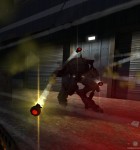
This brings me to the main reason why the spooky segments of the game don’t really work: the action sequences. Why should we fear the things that go bump in the night, when we have a real threat to face? After a short while of gameplay, it becomes all too apparent that none of the spooky stuff occurs within any area that features combat. You can usually hear or see enemies before they spot you, so it is easy to tell when a combat segment is about to begin. Between these combat segments, there are breaks in the action. We travel through hallways, collect items, perhaps see some bloody footprints appear on the floor, and so on, until we sense that combat is starting again. During these breaks, you’re not being shot at, and therefore not losing health. Because the breaks are harmless, and distinct from the action sequences, the spooky moments contained within fail to be threatening. In addition, you’re always holding a gun, which is an empowering state. If a flickering light bothers you, just shoot it! Later in the game, the action and horror sequences begin to meld together, and you start shooting at ghosts. At this point, it feels like the game had finally got its act together, and made an effort to imbue danger into its spookiness.
The Actual Horror
There is, however, something genuinely creepy about the game, and it’s an unintentional breed of creepy. Eventually, you will follow Fettel to the corporate headquarters of Armacham, a military defense contractor. Out of the game’s 21 playable maps, this section is composed from 9 of them, making it the longest part of the game. Due to the sheer length and repetitive level design, the Armacham complex itself exudes its own creepiness.
To understand what makes the level design creepy, we should briefly discuss how level design has evolved over the years. The vast majority of levels from early video games did not represent anything in particular; terrain and architecture appeared to be random, outside of the perspective of game design. Consider, for example, the classic E1M1 “Hangar” level from Doom. Nothing in that level even remotely resembles a hangar, but players didn’t really care about that. It was designed as a course, littered with enemies, obstacles, goodies, and secrets. As time went on, technology grew more powerful, and level designers were expected to add more detail into their worlds. With increased detail came increased realism, and levels were expected to be plausible representations of the locations they depicted. It can be tricky to combine good level design with a plausible setting. Half-Life is an example of a game that pulled this off remarkably. When a well-detailed level is acceptable from a game design perspective, but the world it depicts fails to be plausible, the result is an unsettling dissonance.
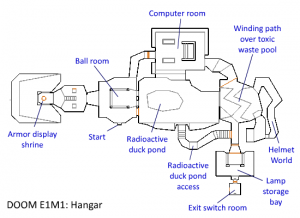
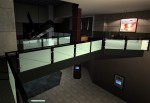
The Armacham corporate headquarters are unsettling because we are exposed to so much of it. If this section of the game were shorter, or if it were played in small doses, it wouldn’t raise an eyebrow. However, the adventure inside the office building consists of 9 entire maps, and each map is pretty large. At first, it just seems boring; a seemingly endless series of hallways, offices, and rooftops. In fact, we get bored of it in advance; most of the surfaces in the game, by a wide margin, are composed of grey concrete. Before arriving at the headquarters, the environments we explored were all nondescript industrial buildings. It isn’t until we enter the office building that we can properly identify our surroundings. If we stop to look at the drab scenery, we notice all the detail and care that went into making it. The rooms are well-furnished. There are employee lounges. You see ceiling tiles have been dislodged, exposing the pipes and cables above. Hey, the windows of this conference room have vertical blinds that swing when bodies fly through them! Check out this sweet atrium! They have wall monitors and information kiosks all over the place! Wouldn’t this be a nice place to work?
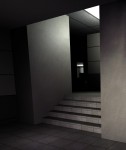
Suddenly, the magic happens; the appreciation of detail clashes with the banality of the overall experience. Holes begin to appear in the fabric of plausibility. We start asking questions. Why are there so many atriums? Why do the atriums span from the roof to the 6th floor, instead of the ground floor? Why do we have waiting areas in the middle of nowhere? Why does one building need over 20 elevator shafts? How come this building contains miles of maintenance corridors, and why are most of them around the rooftops? Why is so much of the building under construction? Are they building an extension? Did they run out of room from having so many corridors? Why are there stairs on the 5th floor that go up 3 feet? Am I on floor 5½ now? Why are there so many rooms with multiple levels, or with their own staircases? Was the architect obsessed with vertical diversity? Who uses these information kiosks? Why is there an irregularly-shaped shaft of nothing, that extends from what I assume to be a pool of sewage in the basement, all the way up to just below the roof? HOW MANY ROOFTOPS MUST THIS GODDAMNED BUILDING HAVE?! WHEN WILL THE OFFICES STOP?!
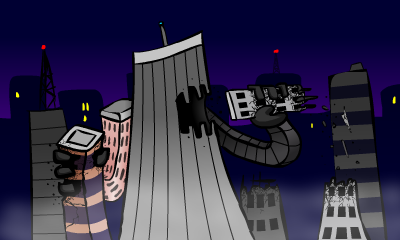
Creepy girls and psychic vampires have nothing on this. You can throw in all the jump scares and string stings you want, but it can never be more disturbing than an endless office building that doesn’t make sense. I was Foraging Errant, Anomalous Rooms. It was a Frenetic, Eldritch, Architectural Rigmarole. I Fled Entire Archipelagos of Roofs. I was Forever Enduring the Accounting Roundabout. The Floor Elevation Altered Randomly. I Found Enormous Atriums Regularly. I can only imagine that the Armacham building is some sort of ravenous skyscraper beast, roaring at the heavens, extending vast pseudopods of concrete and glass in order to consume neighboring buildings. I’m convinced that it must be composed of the many smaller buildings it had devoured. At some point, you are tasked with going to the “Executive Building” in order to find someone. This “Executive Building” is part of the rest of the building; you never cross the street, or see any kind of alley, separation, or interruption between it and the rest of the complex. It must have been a different building before it was enveloped and digested.

